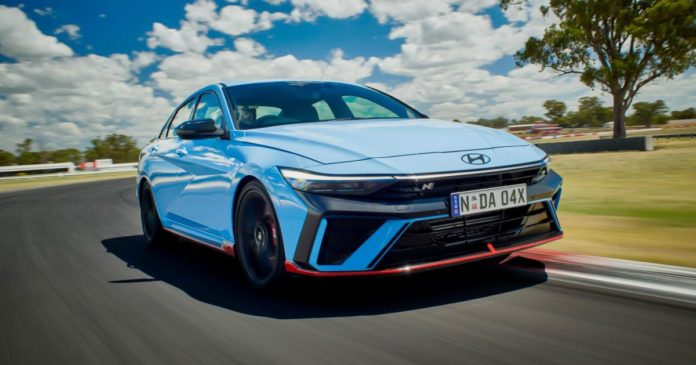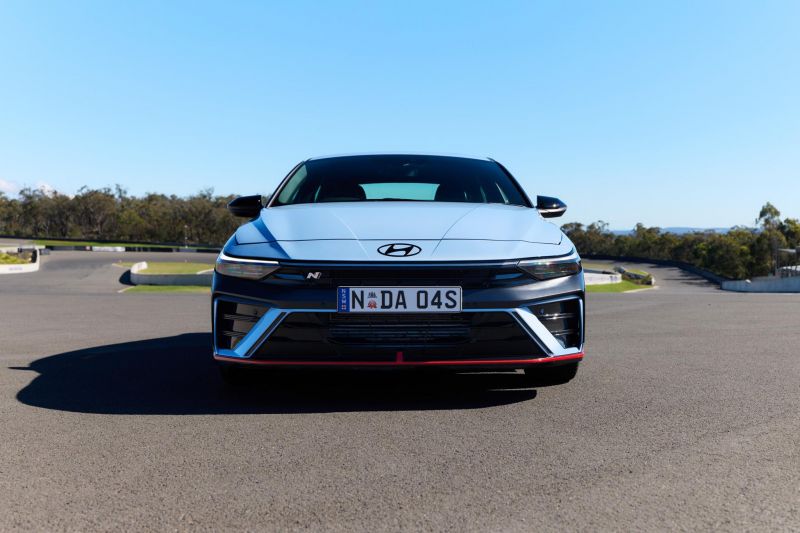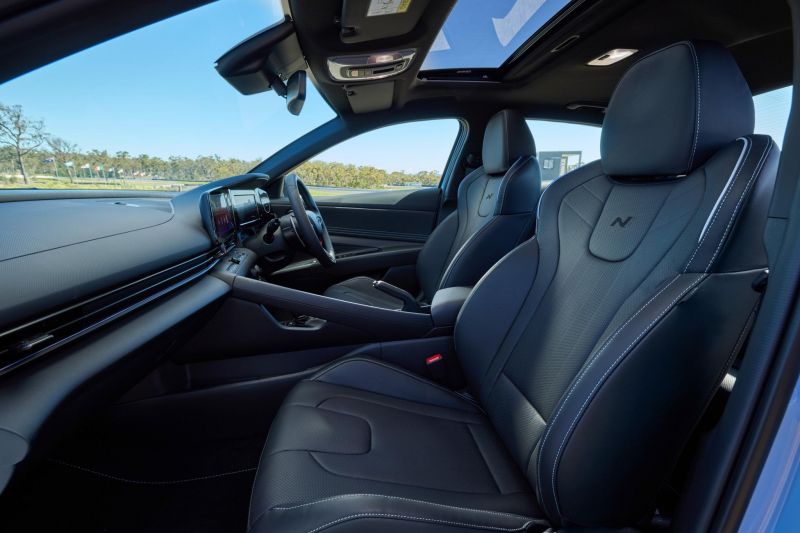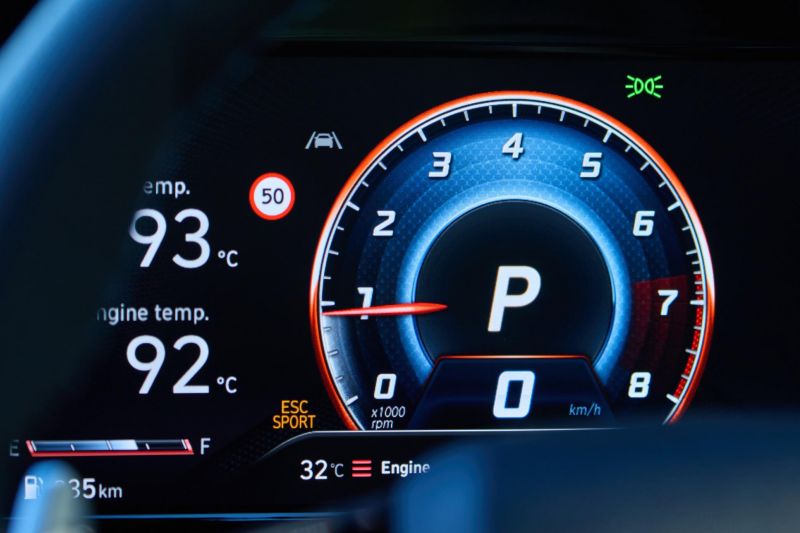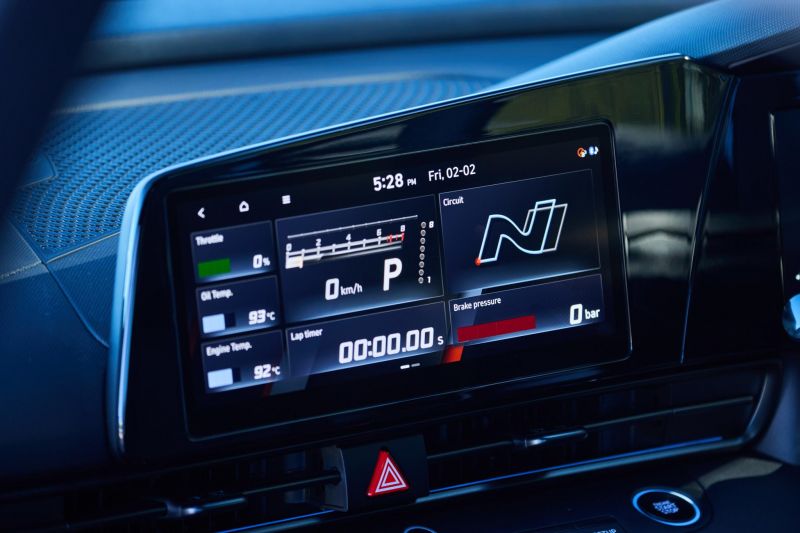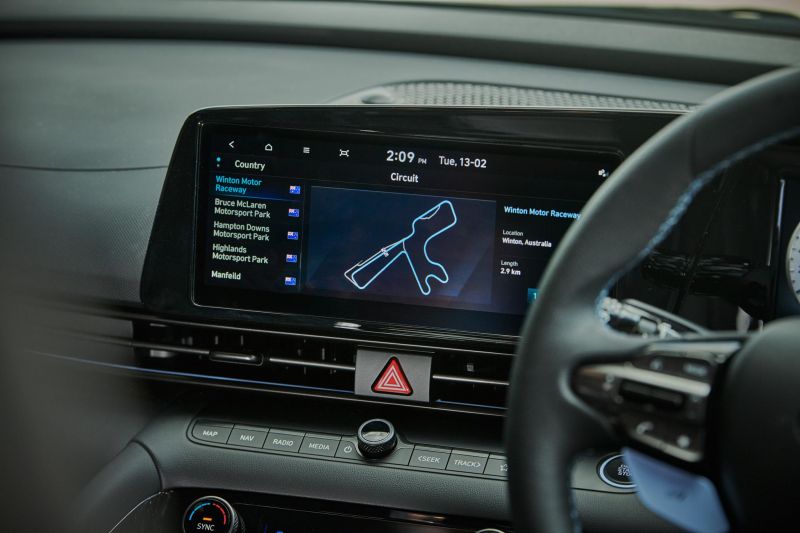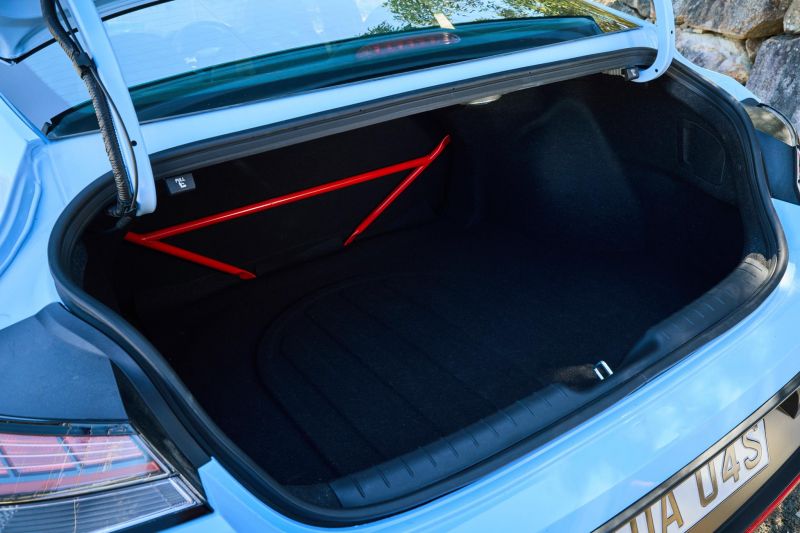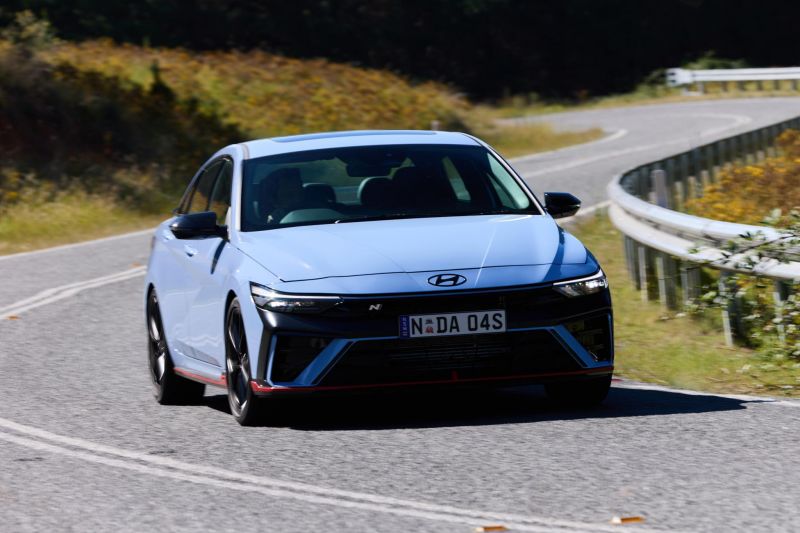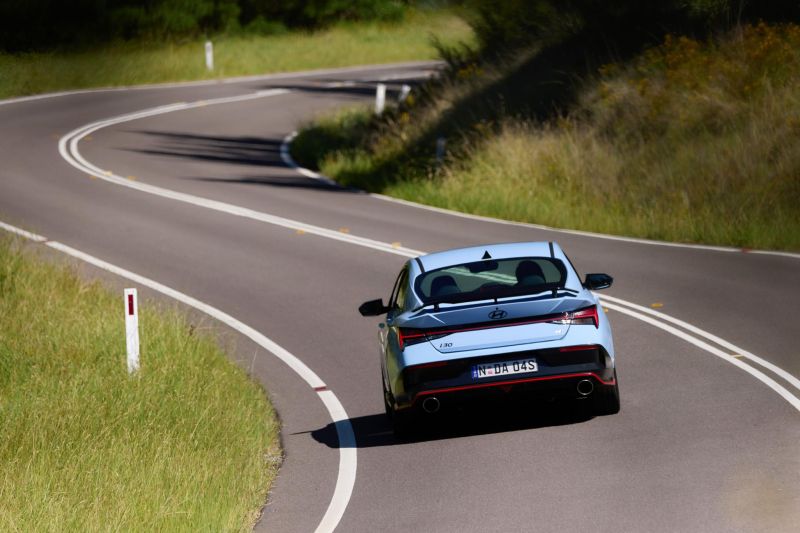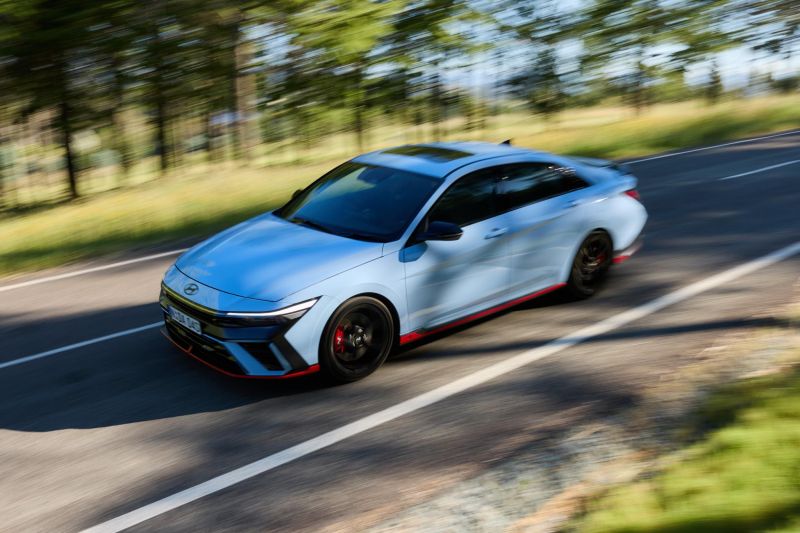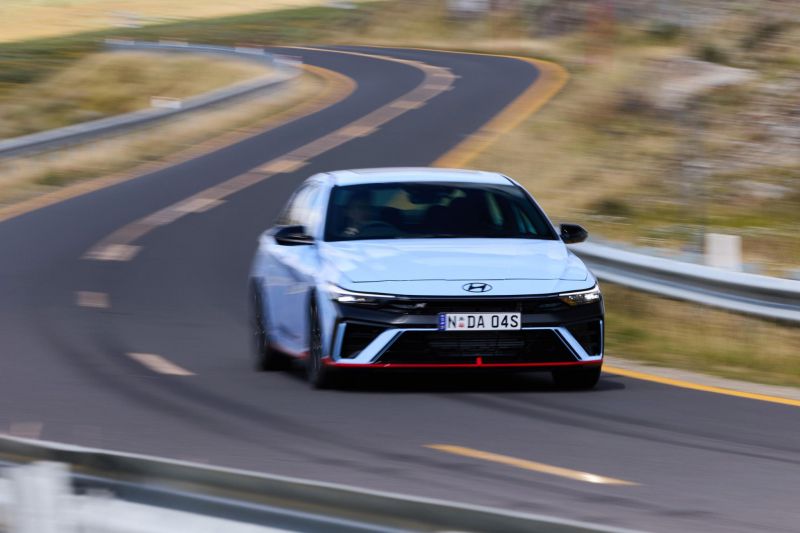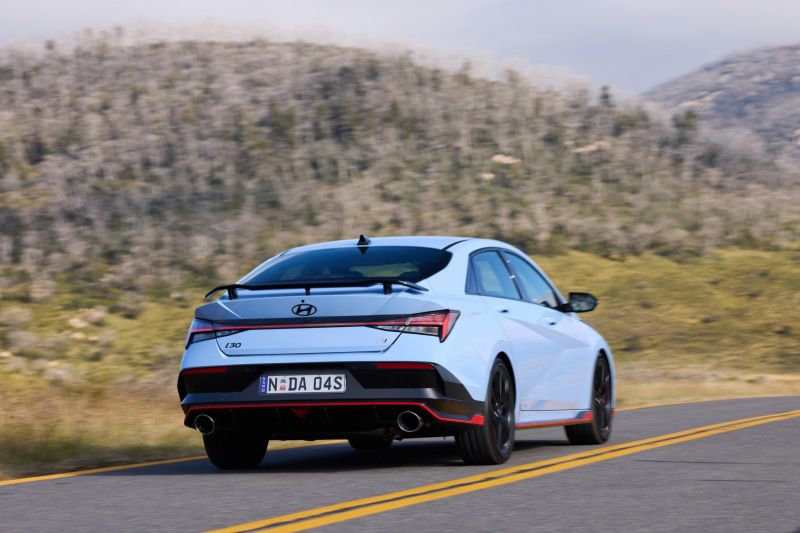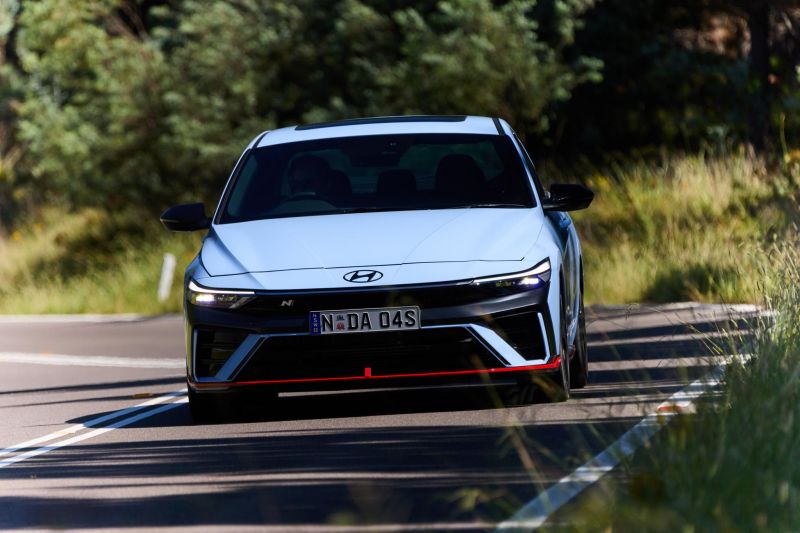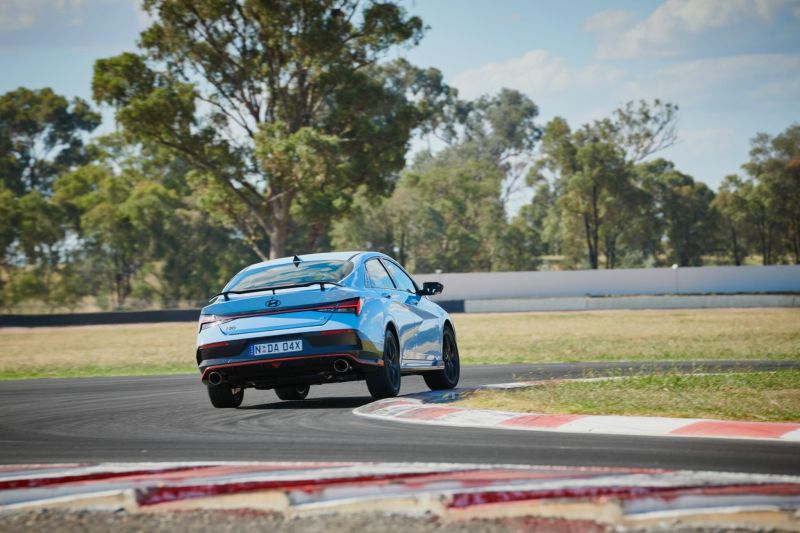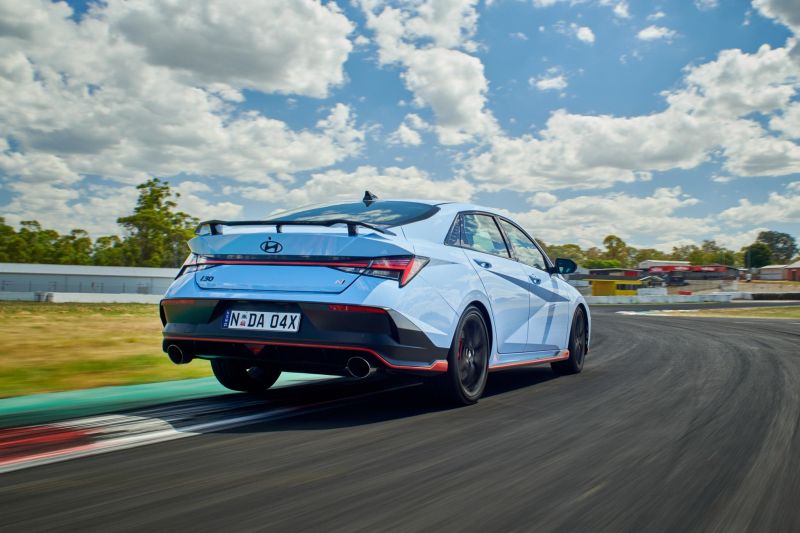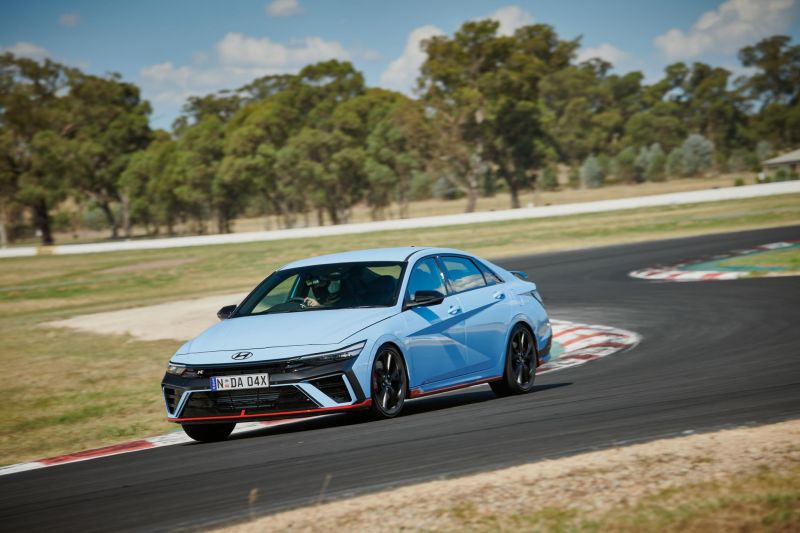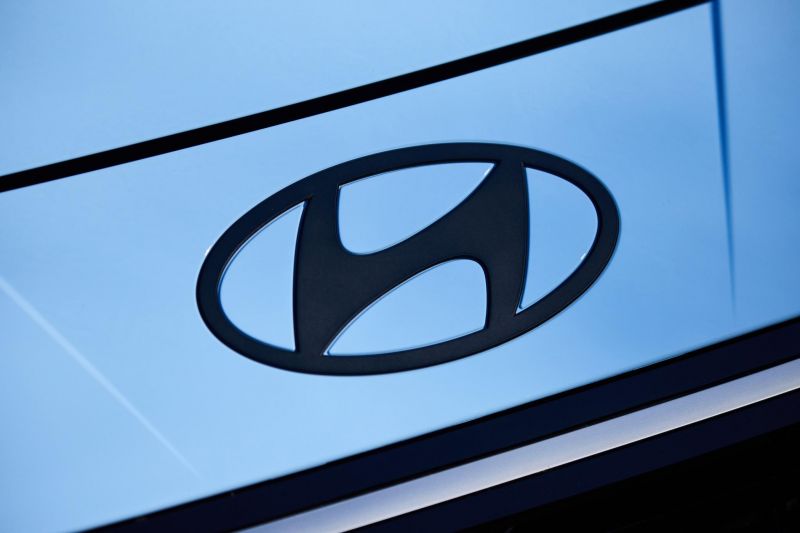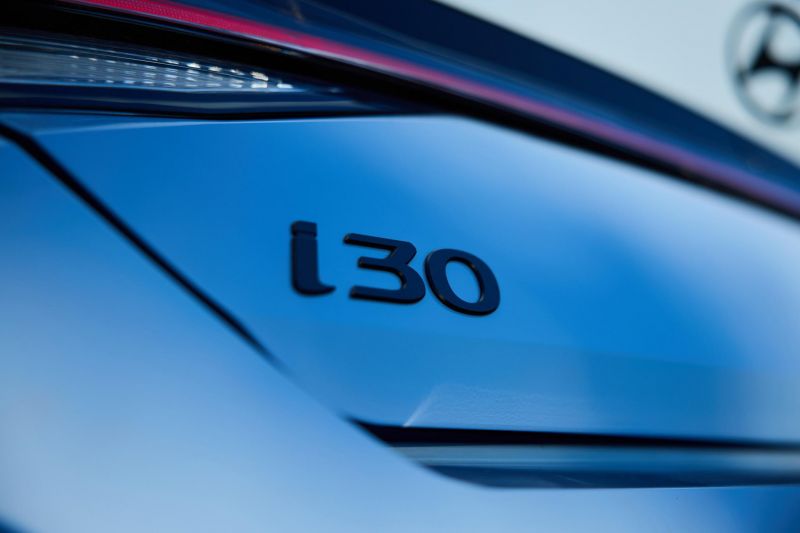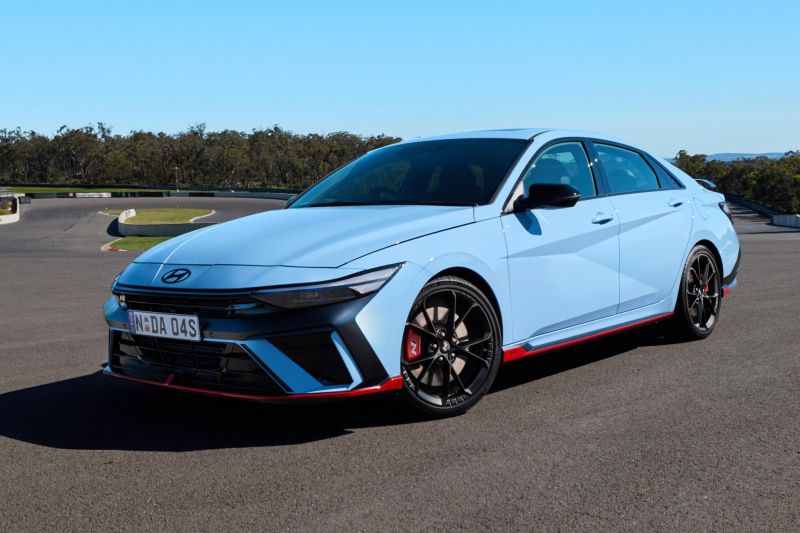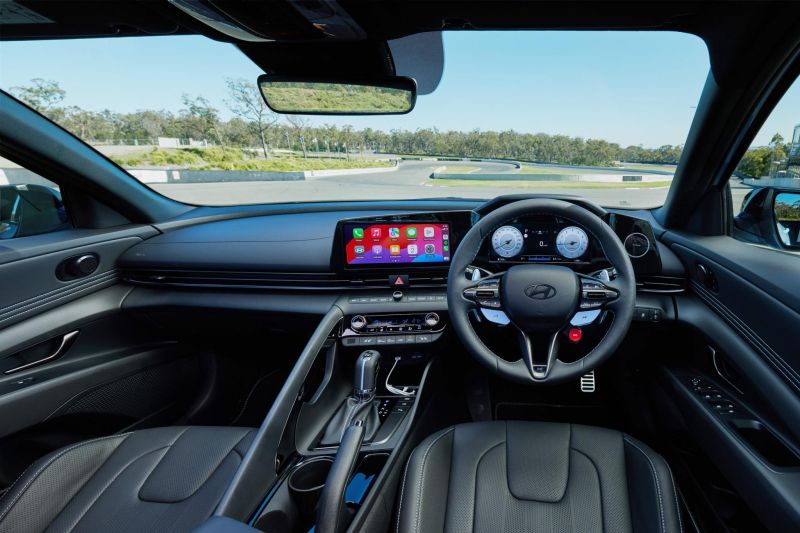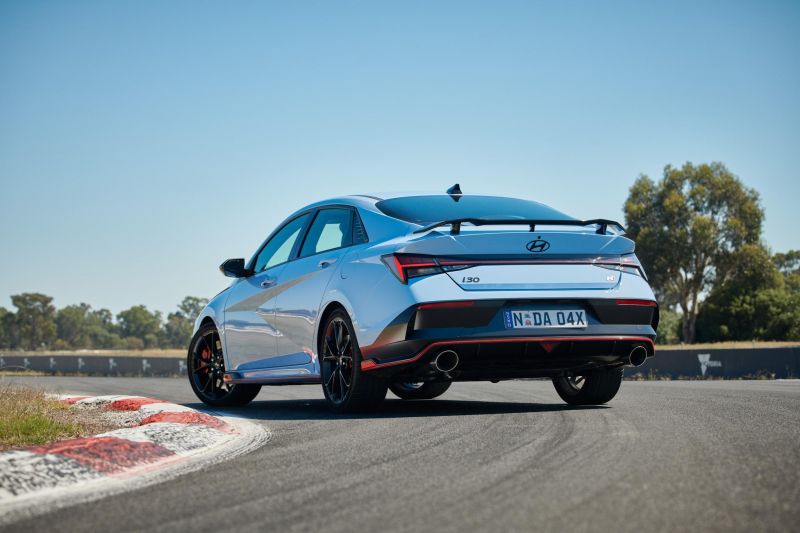The Hyundai i30 Sedan really is the car that can do it all.
With this latest update to the small sedan you can now get it with an uber-efficient hybrid powertrain. On the other hand however, the high-performance N variant on test here has been retained and tweaked.
On the outside the i30 Sedan N has picked up a new front and rear bumpers, revised LED lighting, new lightweight 19-inch forged alloy wheels, and flat black aluminium badging.
There’s also updated steering components, redesigned upper engine mounts, revised dampers, polyurethane rear strut bushes, added front brake hose insulation, as well as an updated electronically controlled suspension (ECS) tune. All of these changes are claimed to elevate the vehicle’s dynamics.
Other new features include speed sign recognition, Intelligent Speed Limit Assist, a revised wireless charger, USB-C outlets, and Bluelink connected car services.
In Australia the i30 Sedan N is still only offered in a single highly specified Premium variant. Both the manual and dual-clutch automatic transmission options have been carried over.
Has the update to this smile-inducing car been comprehensive enough to keep up with the competition? Read along to find out.
How does the Hyundai i30 fare vs its competitors?
View a detailed breakdown of the Hyundai i30 against similarly sized vehicles.

Hyundai
i30
How much does the Hyundai i30 Sedan N cost?
Just one spec is available for the facelift, as per its predecessor.
2024 Hyundai i30 Sedan N pricing:
- 2024 Hyundai i30 Sedan N Premium 6MT/8DCT: $52,000 (+$1500)
Price excludes on-road costs
To see how the Hyundai i30 compares with its rivals, use our comparison tool.
What is the Hyundai i30 Sedan N like on the inside?
Walking up to the 2024 Hyundai i30 Sedan N it certainly has some presence. You’ll either love the design of the updated i30 Sedan N or hate it, but there’s no denying it turn heads and stands out on the road.
Hopping in it’s a bit of a step down, but this is pretty typical given it’s a sedan. If you’ve got a racing helmet on you’ll really have to remember to duck your head.
Once you’re in there are a set of chunky and sporty-looking front bucket seats that are finished in black leather and have N embossed on the backrest. They hug you in tightly, which is reassuring, and offer plenty of support while not being too firm.
We miss out on the proper lightweight N bucket seats available in Korea as they’re not compatible with Australian Design Rules (ADRs).
Both front seats offer both heating and ventilation which feels pretty special in a performance-oriented vehicle. The latter is handy when you first hop in on a hot day, as well as when you’re attacking a race track.
The driver’s seat in particular offers 10 ways of electric adjustment, including lumbar. Despite this however it makes the seating position a little bit higher than you would ideally want. It’s not world ending, but you if you were a slightly lower you’d feel even more connected to the car.
Ahead of the driver is a chunky and sporty-looking steering wheel that has perforations on it to allow your sweaty hands to breathe. It’s also heated which is a godsend when you hop in on a cold morning.
There are a number of clicky physical buttons on the steering wheel which at first can make it feel a little overwhelming. Once you’re acquainted with it however, they’re all logically placed.
The steering wheel buttons unique to the i30 Sedan N are the two large blue N Custom buttons which cycle through N and N Custom driving modes, as well as the ominous circular red button. With the manual this turns on auto rev-matching, whereas with the DCT it turns on N Grin Shift.
Behind the steering wheel is a 10.25-inch digital instrument cluster that remains unchanged from the pre-update model. It appears to be high-resolution and easy to read, even when you’re blitzing it around the track.
The digital instrument cluster’s appearance depends on which drive mode you have selected. You are able to lock it in a particular style if you’d like, but that’s not very fun.
In the standard drive modes the looks are very typical Hyundai with circular speedometer and rev dials sandwiching a central section that can display different informative pages. It’s a little annoying a digital speedometer can’t be viewed at all times in this mode.
When activating an N driving mode however this is when the car comes alive. There’s a really cool animation that spreads across the entire digital instrument cluster to let you know this is something serious.
The digital instrument cluster then shows critical information like your revs and digital speedometer in the middle, and other performance-related information on each side.
Moving across there’s a 10.25-inch touchscreen infotainment system that remains unchanged from the pre-update i30 Sedan N. Speaking of unchanged things, the strange circular design element on the right-hand side of the digital instrument is still there. It still doesn’t appear to serve any purpose.
The touchscreen appears to have enough processing power, which means it boots up quickly upon startup and new pages load snappily. Swiping around is easy, though reaching the far side of the screen from the driver’s seat is a bit of a stretch.
While the touchscreen may seem pretty simple on the surface, once you open the N Mode program this unlocks another level of functionality. You can view performance data, adjust your N Custom drive modes, and start lap timers, among other functions.
Just like the pre-update model, the updated i30 Sedan N still only offers wired Apple CarPlay and Android Auto through a USB-A port. With my iPhone 15 Pro Max plugged in I didn’t experience any dropouts, which is how it should be.
Bluelink connected services are offered as standard in the updated i30 Sedan N, which includes functions such as connected satellite navigation, voice recognition, emergency calling, and remote climate control, among others.
Looking around the cabin there are a large number of dark and black finishes. You can option a tilt and slide glass sunroof for $2000 which lightens up interior ambience just a tad, but this arguably goes against its high-performance intent.
The main touchscreen points where your arms rest are soft, though looking around a bit closer there are plenty of hard plastics. There’s also an annoying amount of piano black in main areas like around the cupholders which gets grimy really quickly and also scratched when you clean it.
The manual variant still receives a meaty leather-wrapped gear shifter that feels substantial in the hand and is a joy to throw around, whereas the DCT variant still gets a similarly thick leather-wrapped gear selector. There are also large paddle shifters in the DCT variant if you want to decide which gear you’re in.
A manual handbrake has been retained with the update which is nice to have but eats up a fair bit of centre console space. An electric park brake is available in other markets which also brings auto hold.
Moving to the second row I’m continually blown away with how much space there is back there. At a leggy 182cm tall there’s plenty of leg, head, shoulder and toe room. Two adults fit in the second row easily, though having someone sit in the middle seat makes things a touch squishy.
Second-row amenities include rear console-mounted air vents, USB-C ports, and a singular map pocket on the back of the front passenger seat. There are also the requisite child-seat mounting hardware (ISOFIX and top-tether points).
Strangely there is no fold-down centre armrest in the i30 Sedan N, which means if you have drinks you’ll need to stow them in the door bin.
Around the back there’s a hands-free opening boot which is handy if you’ve got your hands full. It doesn’t close by itself however, so you’ll need to push it down yourself.
Hyundai quotes an official boot capacity figure of 464 litres, which doesn’t sound amazing on paper, but in reality it’s properly deep. One downside that’s inherent to sedans though is the boot opening is a little small.
There really aren’t many features or notable amenities in the i30 Sedan N’s boot despite the large rear stiffness bar mounted just behind the rear seats that’s painted red and takes up the entire width of the boot.
This rear stiffness bar is claimed to increase torsional rigidity by 29 per cent compared to the base car, though it does come at the cost of practicality. The rear bench also only folds as one piece, which could be a bit of a hassle if you’re wanting to transport more than two passengers.
Lastly, it’s nice to see the updated i30 Sedan N still gets a spare wheel. Sure it’s a small temporary space saver spare wheel, which isn’t as good as a proper full-size spare wheel, but it’s much better than a pesky tyre repair kit or nothing at all.
What’s under the bonnet?
There are no major changes for 2024.
| Model | Hyundai i30 Sedan N |
|---|---|
| Engine | 2.0-litre 4cyl turbo |
| Power | 206kW (5500-6000rpm) |
| Torque | 392Nm (2100-4700rpm) |
| Transmission | 6-speed manual or 8-speed dual-clutch auto |
| Driven wheels | Front-wheel drive |
| Kerb weight | 1499kg (manual), 1539kg (DCT) |
| Fuel economy (claim) | 8.5L/100km (manual), 8.3L/100km (DCT) |
| Fuel economy (observed) | 9.6L/100km (160km rural spirited driving in manual) |
| Fuel economy (observed) | 7.0L/100km (200km highway driving in DCT) |
| Fuel tank size | 47 litres |
| Fuel requirement | 95 RON |
To see how the Hyundai i30 compares with its rivals, use our comparison tool.
How does the Hyundai i30 Sedan N drive?
Now this is where the fun really begins.
Starting up the Hyundai i30 Sedan N with a push of its start button provides you with a snarly growl from the engine. This is even more pronounced when the engine is cold.
Sure your neighbours might hate you just a touch when you first start up the car, but it quickly quietens down after a bit once the engine has warmed up a bit. That’s unless you have an N mode activated, then they’ll continue to despise you.
Setting off in the manual in particular can take a bit to get used to. For the first couple of starts don’t be surprised if you do stall, which can be embarrassing, especially if you’re trying to impress someone.
If don’t want to risk stalling however, there is the eight-speed dual-clutch automatic available as a no-cost option. Thankfully this doesn’t have as steep of a learning curve.
Like a number of dual-clutch transmissions, the i30 Sedan N’s can be a little jerky at low speeds. It feels like it’s either on or off. The transmission also feels out of its depth when you’re trying to roll along with traffic at low speed.
It’s also obvious the eight-speed dual-clutch automatic transmission is geared for performance, rather than efficiency. It will frequently rev first and second gears all the way out to around 3000rpm, which feels a bit high given peak torque comes on tap from 2100pm.
Speaking of performance, there’s plenty of it. You’ll easily be keeping up or pulling ahead of other cars at the traffic lights. Just be careful however because if you’re too zesty with the accelerator there will be a bit of front axle tramp which is never a nice feeling.
The i30 Sedan N with the six-speed manual transmission specifically receives a rev-matching function which is handy for those who don’t know how to heel-toe downshift. I really like this feature as it makes driving the manual less intimating and more approachable.
The i30 Sedan N with the eight-speed dual-clutch automatic transmission on the other hand receives a feature call N Grin Shift (NGS). It’s activated by pressing a button on the steering wheel which then releases maximum power from the engine and transmission for 20 seconds.
Like the name suggests, NGS really does bring a smile to your face. The car feels like it comes alive and it’s properly quick. After the 20 seconds of NGS has elapsed it takes 40 seconds for the system to regenerate before going again.
Another unique feature to the dual-clutch automatic is N Power Shift which engages when you’re accelerating with more than 90 per cent of the accelerator. It reduces torque drop-off during gear shifts which creates a manual-like shove in the back. It’s incredibly satisfying and adds such a visceral element to driving the car fast.
Like I mentioned before, the i30 Sedan N can be driven around quietly if you’d prefer to not annoy your neighbours, but it can also be really loud and in your face.
The amount of pops, cracks and bangs the car’s exhaust produces, even in normal mode, is so much fun. If you’re feeling properly chaotic, try letting off the accelerator from above 5000rpm in a tunnel with N mode activated.
It’s good to see the i30 Sedan N has retained all the exhaust cracks and pops with the update. It will be a sad day once these are muted. Not many other cars sound like this anymore due to emissions and noise regulations.
There are quite a number of drive modes offered in the i30 Sedan N. There’s the typical Eco, Normal and Sport modes, as well as high-performance N, N Custom 1 and N Custom 2 drive modes.
The latter two of these drive modes can be customised through the touchscreen infotainment system. Parameters that can be customised in terms of their intensity include the engine, suspension, electronic stability control (ESC), electro-mechanical limited-slip differential (e-LSD), active variable exhaust, steering, and transmission.
This allows you to dial up how sporty certain elements of the car feel, while keeping others more conservative. My favourite was having the engine and exhaust all the way up to Sport+, while keeping the steering and suspension at its softest.
At low speeds is where the i30 Sedan N feels at its weakest. The steering is a little too heavy and the e-LSD makes the car feel a touch cumbersome. It also has large 11.7-metre minimum turning circle, which will see you doing a fair few three-point turns.
There are front and rear parking sensors available as standard, while in Australia there’s only a reversing camera. There’s a surround-view camera offered in other markets. Thankfully the single rear-facing camera offered in this car has adequate quality.
If you’re expecting the i30 Sedan N to be soft and supple at low speeds, think again. Even in its softest setting the suspension still tends to err on the firmer side which will see you grimace over speed bumps and pot holes.
Dialling up speed is too easy to do in this car. There’s a touch of turbo lag which is charming, but you’ll need to keep an eye on your speed. Thankfully you’ll be reminded of your speed in another way, but more on that later.
Annoyingly at higher speeds the car produces an absolute bucket-load of road noise. This is down in part to the sticky Michelin Pilot Sport 4S tyres fitted as standard. Thankfully you can also turn up your music to drown this out a bit.
It’s very obvious the i30 Sedan N is very keen to be driven hard and fast. While the steering and LSD are annoying at lower speeds, they help you feel more connected to the car and go faster at higher speeds.
This also cascades down to how the suspension which feels more comfortable and settled at higher speeds.
During the local launch of this vehicle I was lucky enough to get a demonstration of how the i30 Sedan N’s electronically controlled suspension (ECS) works.
As part of this demonstration, Hyundai Australia product planning and development manager Tim Rodgers, plugged in a laptop and remapped how the suspension and dampers work and created hard limits – one completely soft, one 50 per cent hard, and then one 100 per cent rock hard.
The completely soft ECS setting felt comfortable at lower speeds but as you sped up the car felt like it bounced around a bit too much.
The 100 per cent stiff setting on the other hand was way too hard for normal driving. It was like the dampers were completely locked up as you felt every single bump and nuance on the road.
Thankfully the ECS system doesn’t actually work like this in reality, with it able to dynamically adjust damping at each corner of the car up to 200 times a second. How it works in the Normal and Sport driving modes has also been locally tuned.
You’ve waited long enough. It’s finally time to talk about how this car goes on track. We drove the car on Winton Raceway in particular.
The updated i30 Sedan N has really solid power on track. You’ll be picking up speed in no time and before you realise you’ll be at your next braking point.
With the dual-clutch in particular, there’s an N Track Sense Shift function that recognises when the road conditions are optimal for dynamic driving and activates automatically. It selects the right gear and shift timing to extract as much performance from the car as possible.
The e-LSD is helpful on track because it allows you to get on the power earlier without smoking the front tyres or understeering too much. In order to be going the fastest however you need to make sure the steering wheel is facing straight.
Thankfully this is also when the Michelin Pilot Sport 4S tyres comes into their own and help to provide heaps of grip. You’d be surprised with how much speed you can carry through sweeping corners.
Braking power is solid in the i30 Sedan N, though it can get a little long after relentless long braking zones. Despite this, the car will happily be driven hard on track for plenty of laps at a time.
One fun aspect of the i30 Sedan N on track is when you’re slowing down and turning in the rear end feels like it kicks out just a bit to help out with rotating the car.
On the geekier side, there are also a growing range of racing tracks that are built into the i30 Sedan N’s infotainment system. With these we were able to track how fast our lap times were at Winton Raceway.
Like a growing number of Hyundai, Genesis and Kia vehicles, the updated i30 Sedan range, including the N variant on test here, has picked up Intelligent Speed Limit Assist.
This system plays a single chime when a new posted speed limit is detected, and then plays another chime when a driver travels at least 2km/h over the limit.
This is one of the most annoying and frustrating safety systems currently offered in new cars at the moment because it’s annoyingly loud, often incorrect, and defaults to on every time you turn on the car.
You can turn the Intelligent Speed Limit Assist off, but you need to do it by diving deep into a menu on the touchscreen. Thankfully you can set up a shortcut button on the steering wheel to eliminate a couple of steps, but you still have to do this every time you start up the car.
Just like the pre-update model, there’s no adaptive cruise control offered. It’s just regular cruise control instead, which is sometimes refreshing because it won’t slam on the brakes when a car merges in ahead of you.
The lane-keep assist function tended to be a bit intrusive, while the Lane Following Assist (lane centring) function can get confused easily. The latter of these systems is best reserved for use on road or highways that are clearly marked.
What do you get?
Just one spec is available for the facelift, as per its predecessor.
i30 Sedan N Premium highlights:
- Active variable exhaust
- Electronic Controlled Suspension
- Electro-mechanical limited-slip differential
- N Grin Shift (DCT only)
- N Performance Driving Data System
- Performance brake package
- Rear stiffness bar
- Track Maps
- 19-inch forged black alloy wheels
- Michelin Pilot Sport 4S tyres
- Proximity entry with push-button start
- Remote start
- Hands-free opening boot
- Automatic LED headlights
- Automatic high-beam
- LED brakes lights
- LED rear fog light
- Rain-sensing wipers
- Power-folding exterior mirrors
- Solar control glass
- Tyre pressure monitoring
- 10.25-inch digital instrument cluster
- 10.25-inch touchscreen infotainment system
- Wired Apple CarPlay, Android Auto
- DAB+ digital radio
- 8-speaker Bose premium sound system
- Wireless phone charger
- Dual-zone climate control
- USB-C outlets front and rear
- Alloy sports pedals
- Leather upholstery
- Front sports seats
- Heated and ventilated front seats
- 10-way power driver’s seat with memory
- Electro-chromatic interior mirror
An electric tilt and slide glass sunroof is a $2000 option.
Colours
There are a total of seven exterior paint colours available on the i30 Sedan N.
Available colours on the i30 Sedan N include:
- Performance Blue
- Atlas White
- Cyber Grey
- Ultimate Red
- Abyss Black
- Ecotronic Grey
- Intense Blue
All exterior paint colours besides Atlas White and Performance Blue cost an additional $595.
Is the Hyundai i30 Sedan N safe?
The Hyundai i30 Sedan has never been assessed by ANCAP or Euro NCAP.
The Insurance Institute for Highway Safety (IIHS), an US safety authority, gave the updated i30 Sedan range (or Elantra, as it’s known there) a Top Safety Pick+ rating, which is its highest rating.
Standard safety equipment includes:
- 6 airbags
- Autonomous emergency braking
- Car, Pedestrian, Cyclist detection
- Blind-spot assist
- Rear cross-traffic assist
- Safe Exit Warning
- Lane keep assist
- Lane Following Assist (lane centring)
- Traffic sign recognition
- Intelligent Speed Limit Assist
- Driver attention warning
- Front and rear parking sensors
- Reversing camera
- Bluelink connected services (5yr subscription)
- Automatic collision notification
- Emergency call function
- Connected routing
- Alert services
- Remote climate control and vehicle functions
- Navigation send to car
- Voice recognition for POI lookup, vehicle controls
- Live weather information
- Vehicle settings management
It’s worth noting other markets like South Korea receive safety equipment like additional airbags (total of eight), adaptive cruise control, Blind Spot View Monitor, surround-view camera, and built-in dashcam. None of these are offered in Australia.
How much does the Hyundai i30 Sedan N cost to run?
The Hyundai i30 Sedan N is covered by a five-year, unlimited-kilometre warranty.
Logbook servicing is required every 12 months or 10,000km. The first five services are capped at the following:
| Service | Cost |
|---|---|
| 12 months/10,000km | $335 |
| 24 months/20,000km | $335 |
| 36 months/30,000km | $395 |
| 48 months/40,000km | $395 |
| 60 months/50,000km | $335 |
CarExpert’s Take on the Hyundai i30 Sedan N
There’s no way around it – the Hyundai i30 Sedan N is an absolute ripsnorter of a car that makes you smile from ear to ear every time you fire up the engine and drive it.
For its price point, this car is somewhat of a performance car bargain. All its notable rivals are considerably more expensive and don’t provide quite the same amount of smile for your buck.
Cars like this are few and far between now, with so many high-performance cars getting duller and less zesty exhaust notes.
This update to the i30 Sedan N has brought a range of meaningful dynamic upgrades to the car, though they won’t really be felt in everyday driving. They will be noticed the most when you’re pushing the car on track for a longer period of time.
While exterior styling is subjective, I’m yet to warm to the updated i30 Sedan N’s whale shark-like mouth and 19-inch forged alloy wheels. For now I much prefer how the pre-update model looks.
Speaking of the pre-update model, I really hate the Intelligent Speed Limit Assist that has been added with this update. It’s loud, inaccurate and can’t be turned off permanently which is such a pain given it’s not mandated in Australia.
That aside however, you really can’t go wrong with the Hyundai i30 Sedan N. Whether you opt for the six-speed manual or eight-speed dual-clutch auto, you won’t be disappointed.
Click the images for the full gallery
MORE: Buy a Hyundai i30
MORE: Everything Hyundai i30

